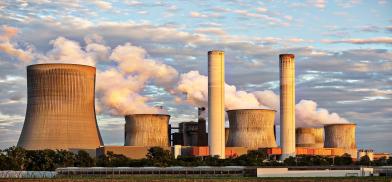Nuclear is the way to go: A transformative shift in India's energy landscape
India has 24 nuclear reactors in operation in 8 nuclear power plants with a total installed capacity of 8,180 MW nuclear power produced a total of 48 TWh in 2023, contributing around 3% of total power generation in India. Due to earlier trade bans and lack of indigenous uranium, India has uniquely been developing a nuclear fuel cycle to exploit its reserves of thorium. India is actively pursuing the development of nuclear energy using thorium as its primary fuel source

India is emerging as a global powerhouse in advanced energy solutions. It is the largest country in the world by population and fifth by size of national economy. It is also the third largest in terms of carbon emissions. According to Jennifer Granholm, US Secretary of Energy, “In so many ways, the world’s energy future will depend on India’s energy future.”
The projected all-India peak electricity demand and electrical energy requirement is 277.2 GW and 1907.8 BU for the year 2026-27 and 366.4 GW and 2473.8 BU for the year 2031-32 as per 20th Electric Power Survey (EPS) demand projections. The energy requirement & peak demand are inclusive of the impact due to increased adoption of electric vehicles, installation of solar rooftops, production of green hydrogen etc. Finding the right energy mix will require leveraging the country’s existing power plants, addressing inadequacies, adding newer technologies, and, addressing inadequacies, and using flexible power to increase system efficiencies using flexible power to increase system efficiencies
In such a circumstance, it is significant that a determined push towards nuclear energy as part of India's long-term energy transition strategy is part of India’s budget for 2025-26 as a mission. The government has set an ambitious target of 100 GW nuclear power capacity by 2047. This development aligns with the broader objectives of ensuring energy reliability and reducing dependency on fossil fuels.
Development of indigenous SMRs
Towards achieving this goal, strategic policy interventions and infrastructure investments are being undertaken, with an emphasis on indigenous nuclear technology and public-private collaborations, recognizing nuclear power as a critical component for achieving energy security and sustainability. This initiative aims to enhance domestic nuclear capabilities, promote private sector participation, and accelerate the deployment of advanced nuclear technologies such as Small Modular Reactors (SMRs).
This Nuclear Energy Mission is focused on research and development (R&D) of Small Modular Reactors (SMRs). The government has allocated ₹20,000 crore for this initiative, aiming to develop at least five indigenously designed and operational SMRs by 2033. In its pursuit the government is exploring partnerships with the private sector to develop and make Bharat Small Reactors (BSRs). BSRs are 220 MW Pressurized Heavy Water Reactors (PHWRs) with a proven safety and performance record. These reactors are being upgraded to reduce land requirements, making them suitable for deployment near industries such as steel, aluminum, and metals, serving as captive power plants to aid in decarbonization efforts. Abandoned coal and other mines are being explored as possible isolated sites suitable from safety and security aspects. In addition to BSRs, the Bhabha Atomic Research Centre (BARC) is developing SMRs for repurposing retiring coal-based power plants and meeting power needs in remote locations.
SMRs are advanced nuclear reactors with a power generation capacity ranging from less than 30 MWe to 300+ MWe, provide a flexible, scalable, and cost-effective alternative to conventional large nuclear reactors, India’s expertise in PHWRs provides a strong foundation for the development and deployment of indigenous SMR designs. The Department of Atomic Energy (DAE) also plans to introduce new nuclear reactors, including high-temperature gas-cooled reactors for hydrogen co-generation and molten salt reactors aimed at utilizing India's abundant thorium resources.
Shift to thorium as primary fuel source
India has a largely indigenous nuclear power programme The nation’s nuclear power programme has proceeded largely without fuel or technological assistance from other countries. As of November 2024, India has 24 nuclear reactors in operation in 8 nuclear power plants with a total installed capacity of 8,180 MW nuclear power produced a total of 48 TWh in 2023, contributing around 3% of total power generation in India. Due to earlier trade bans and lack of indigenous uranium, India has uniquely been developing a nuclear fuel cycle to exploit its reserves of thorium. India is actively pursuing the development of nuclear energy using thorium as its primary fuel source, due to its vast reserves of thorium and limited uranium supplies, with a three-stage nuclear power program aimed at eventually utilizing thorium on a large scale for energy production. This strategy involves first using natural uranium to produce plutonium, which is then used in fast breeder reactors to breed uranium-233 from thorium, ultimately leading to a self-sustaining thorium-based reactor system
While India is actively researching and developing thorium-based reactors, which produce less radioactive waste and offer improved safety, the technology is still under development and faces challenges in achieving large-scale deployment.
Creating conducive environment for investment
As of 2024, only China and Russia have successfully built operational SMRs. There are more than 80 modular reactor designs under development in 19 countries. There are literally dozens of SMRs and microreactor designs being developed by different companies around the world, and some of the work has been going on for decades. Yet, only two designs have actually been built and put into commercial operation.
While India does not currently have a fully operational SMR in place, the country has announced plans to develop and deploy a fleet of small nuclear reactors, essentially constituting SMRs, based on a design derived from its existing 220-megawatt PHWRs; meaning India is actively pursuing SMR technology and aims to build them in the near future. For instance, there is a news item which says, Russian nuclear firm Rosatom has offered India the expertise to build small modular reactors, based on its experience of more than six decades in this sector.
To facilitate and encourage private participation and the implementation of the Nuclear Energy Mission, amendments to the Atomic Energy Act and Civil Liability for Nuclear Damage Act will have to be taken up by parliament. These legislative changes are expected to create a more conducive environment for investment and innovation in the nuclear sector. The mission aligns with India's commitment to achieving 100 GW of nuclear energy capacity by 2047, a milestone deemed essential for reducing carbon emissions and meeting future energy demands. As of January 30, 2025, India’s nuclear capacity is 8180 MW. Hopefully the government will do it quickly.
Accelerating nuclear power development
The provisions for nuclear power in the Union Budget 2025-26 and the determined commentary mark a transformative shift in India's energy landscape. By promoting nuclear energy as a sustainable, scalable, and secure power source, the government aims to bolster energy security and meet the nation's long-term economic and environmental goals. The Nuclear Energy Mission for Viksit Bharat is poised to accelerate nuclear power development, positioning India as a global leader in advanced nuclear technology by 2047.
(The author is an Indian Army veteran and a strategic and contemporary affairs commentator. Views expressed are personal. He can be reached kl.viswanathan@gmail.com)









Post a Comment